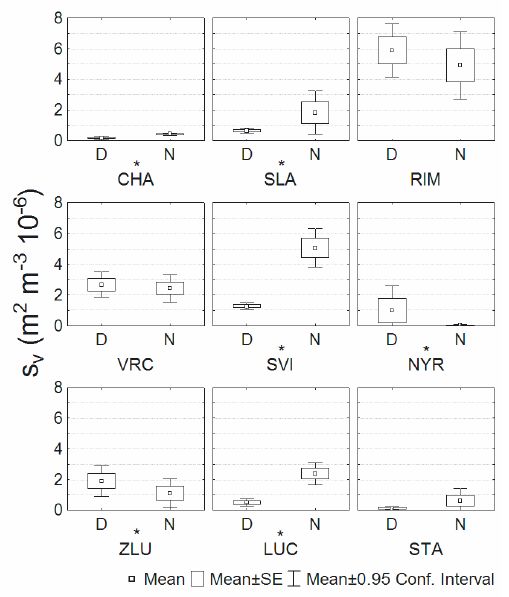 Day and night acoustic surveys were used to compare fish stock estimates at eight European reservoirs and one flooded mining pit. During both photoperiods of summer, higher fish biomass was observed in the uppermost 4 m of the water column by horizontal beaming than in deeper water by vertical beaming. Comparisons of volume backscattering coefficient (sv), fish biomass (kg ha−1), abundance (ind. ha−1) and average fish weight (g) did not show a common pattern among the reservoirs but were found to vary significantly across photoperiods. At most reservoirs, the night surveys had higher estimates than day surveys. However, at several reservoirs the opposite pattern was observed. These patterns could not be explained by the species composition of the fish stocks. Fish size distributions were found to be different between day and night. A higher proportion of 1+ and older fish were found during the night at two of three studied waterbodies. In general, it was not possible to decide whether day or night acoustic surveys gave more reliable fish stock assessments. We advise performing both day and night transects on a given water body before deciding when to conduct the full survey. For a complete fish assessment it is very desirable to combine acoustic mobile surveys with active sampling gear.
Day and night acoustic surveys were used to compare fish stock estimates at eight European reservoirs and one flooded mining pit. During both photoperiods of summer, higher fish biomass was observed in the uppermost 4 m of the water column by horizontal beaming than in deeper water by vertical beaming. Comparisons of volume backscattering coefficient (sv), fish biomass (kg ha−1), abundance (ind. ha−1) and average fish weight (g) did not show a common pattern among the reservoirs but were found to vary significantly across photoperiods. At most reservoirs, the night surveys had higher estimates than day surveys. However, at several reservoirs the opposite pattern was observed. These patterns could not be explained by the species composition of the fish stocks. Fish size distributions were found to be different between day and night. A higher proportion of 1+ and older fish were found during the night at two of three studied waterbodies. In general, it was not possible to decide whether day or night acoustic surveys gave more reliable fish stock assessments. We advise performing both day and night transects on a given water body before deciding when to conduct the full survey. For a complete fish assessment it is very desirable to combine acoustic mobile surveys with active sampling gear.
Keywords: diel migration; fish biomass; hydroacoustics; man-made lake
